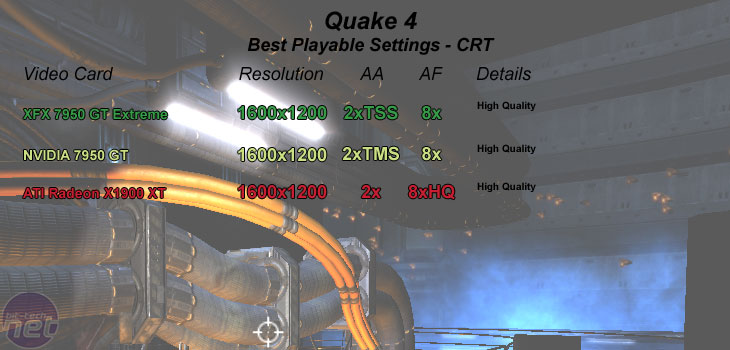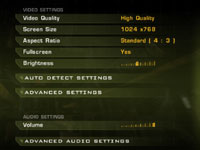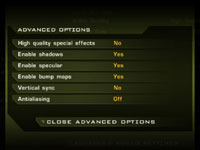For gameplay evaluations on a 24" widescreen monitor, please head straight to our widescreen performance section.
We used the full retail version of Quake 4 patched to version 1.3.0. It is the fourth game in the Quake series, based on the technically sound Doom 3 engine. However, unlike Doom 3, we found that the game benefits from at least 2x anti-aliasing, and the experience with anti-aliasing at a slightly lower resolution was better than increasing the resolution with no AA applied.
Both anti-aliasing and anisotropic filtering were controlled from inside the game. When you select "High Quality" mode, 4xAF is automatically enabled, and when the "Ultra Quality" mode is enabled, 8xAF is automatically applied to the scene.
We did a manual run through from a five minute section of the Nexus Hub Tunnels level and found that a minimum of 15 frames per second and an average of 45-50 frames per second in our test section was deemed to be playable across the rest of the title.

 Quake 4 has been NVIDIA's baby since it was launched and that isn't about to change now. The XFX GeForce 7950 GT 570M Extreme delivered the best gaming experience of the tested cards, as we were able to attain the highest image quality settings, while also maintaining the smoothest frame rates too. We were able to play the game with 2x transparency supersampling anti-aliasing enabled, along with 8xAF at the high quality in-game detail setting.
Quake 4 has been NVIDIA's baby since it was launched and that isn't about to change now. The XFX GeForce 7950 GT 570M Extreme delivered the best gaming experience of the tested cards, as we were able to attain the highest image quality settings, while also maintaining the smoothest frame rates too. We were able to play the game with 2x transparency supersampling anti-aliasing enabled, along with 8xAF at the high quality in-game detail setting.
The reference GeForce 7950 GT was not quite smooth enough with transparency supersampling enabled, so we resorted to using transparency multisampling. This meant that the reference 7950 GT had a slight image quality deficit to XFX's pre-overclocked card, but it was still faster than ATI's Radeon X1900XT, which suffered from the stuttering issues that we've reported many times now.
Quake 4
Publisher: ActivisionWe used the full retail version of Quake 4 patched to version 1.3.0. It is the fourth game in the Quake series, based on the technically sound Doom 3 engine. However, unlike Doom 3, we found that the game benefits from at least 2x anti-aliasing, and the experience with anti-aliasing at a slightly lower resolution was better than increasing the resolution with no AA applied.
Both anti-aliasing and anisotropic filtering were controlled from inside the game. When you select "High Quality" mode, 4xAF is automatically enabled, and when the "Ultra Quality" mode is enabled, 8xAF is automatically applied to the scene.
We did a manual run through from a five minute section of the Nexus Hub Tunnels level and found that a minimum of 15 frames per second and an average of 45-50 frames per second in our test section was deemed to be playable across the rest of the title.


The reference GeForce 7950 GT was not quite smooth enough with transparency supersampling enabled, so we resorted to using transparency multisampling. This meant that the reference 7950 GT had a slight image quality deficit to XFX's pre-overclocked card, but it was still faster than ATI's Radeon X1900XT, which suffered from the stuttering issues that we've reported many times now.

MSI MPG Velox 100R Chassis Review
October 14 2021 | 15:04











Want to comment? Please log in.